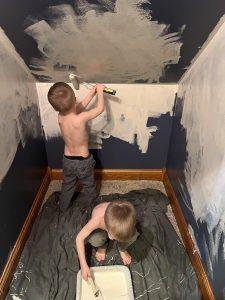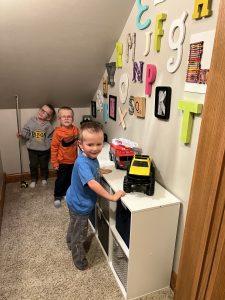So you’re ready to paint a room — maybe it’s a kids bedroom, playroom, or that space under the stairs. Somewhere along the line you’ve told your kids they can help. And now you’re thinking about the logistics and second-guessing yourself.
Don’t panic!
I have a few tips to help ease the stress of painting a room with young children.
Tips for Painting with Young Children
1. Be prepared.
Have absolutely everything you need set up ahead of time. When you are working with a young child, their attention span may not be more than 20-30 minutes, so you don’t want to waste any of that time on prep.
Here’s is the list of supplies that I gather before getting started:
Supplies to have ready to go:
- Paint – You can extend this activity by letting your child help choose paint colors at the store if it’s for their space. Pro tip: Select three colors you are actually OK with using and have them pick from those options.
- Cheap paintbrushes – I like the foam ones or the inexpensive chip brushes that are less than one dollar each. Kids will inevitably destroy any paintbrush you give them, so don’t spend a lot of money here.
- Paint roller – to help smooth the walls over after your little Picasso is finished. Preferably a smaller size roller, so it’s not too heavy for littles.
- Paint pan – this allows easier access to paint, room to remove excess paint, and reduces the amount of paint that can be spilled.
- Drop cloth (or old bed sheet, whatever you have on hand that can get dirty) – cover the floor of the entire room you are painting. You can also use painting tape to keep it in place.
- Painting tape – do any taping of areas you don’t want painted ahead of time.
- Baby wipes – these are my secret weapon. They work super slick to wipe off paint from trim or any drips that happen. And they also are great for cleaning off hands!
- Old pants, shirt, even socks. (Learn from my mistakes — it’s much easier to remove a pair of socks than wash off feet before they go sprinting down the hallway!)
2. Paint around everything you want to protect.
In addition to taping off trim or areas you don’t want to get paint on, it’s helpful to “cut in” those areas to keep your child as far from potentially painting them as possible.
Ideally you would do this ahead of time, and paint four to six inches around everything you would like to protect such as trim, light switches, doors, etc. This gives your child a large safe area to paint and reduces stress while you are supervising.

3. Get kids painting!
Now that the space is prepped and everything’s ready to go, it’s time to let the kids start painting!
I like to do a quick tutorial on dipping the brush, removing excess paint, and how you are supposed to brush it on the wall. Kids usually find their own method of actually applying the paint, which is half the fun (and also why we use cheap paintbrushes that can get destroyed).
Let them use brushes first.
After there is a good amount of wall painted, you can bust out the roller to help smooth out the brush strokes. I like to preload the roller for my child and then hand it to them.
This second method of applying paint will help keep them interested longer. It also introduces a fun new skill for kids to work on.
4. Make any necessary touch-ups.
Once they’ve finished, stripped off their paint clothes, and run off to their next activity, it’s time to make touch-ups.
I like to roll over the wall again while the paint is still wet. This smoothes out brush strokes, excess paint, and missed spots.
Prepare yourself for a second coat and (depending on age and how well your kiddos did) decide if you will invite them to help on the final coat.
Hopefully these tips will help reduce any stress or anxiety leading up to starting your next painting project.
It really is a fun and rewarding activity to tackle with your kiddo. They will feel a huge sense of pride when they get to show off the walls they painted. It also is a great life skill for kids to learn!
















